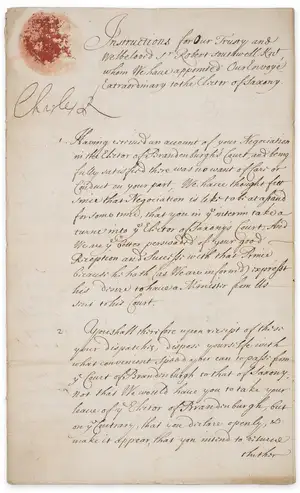Lot 85
Arabic manuscript.- Abu Nuwas al-hasan b. Haniʾ al-Hakami. Diwan, copied by Muhammad bin Abi Turab, c.1287 AH [c.1870 CE].
Hammer Price: £700
Description
Arabic manuscript.- Abu Nuwas al-hasan b. Hani? al-Hakami (classical Arabic poet, c.756-early 9th century CE) Diwan, manuscript in Arabic, on 19th-century Russian wove paper, lightly burnished, with the blind-stamp of Factory No.4 Sergiev(a), c.355pp., copied by Muhammad bin Abi Turab (potentially a pseudonym), in an informal hand, with numerous ink notes and corrections (by the same), trimmed at fore-edge affecting some notes, toning, occasional light staining or soiling, final few ff. almost loose, contemporary sheep, paper label to spine titled in ink, some staining, particularly to head of lower cover, rubbed, lower joint with small loss to head, 4to (215 x 170mm.), n.p., c.1287 AH [c.1870 CE].
⁂ This copy of the Diwanis in the recension of al-Suli, the earliest of those in circulation, divided into ten chapters, arranged by theme (wine poetry, love poetry (including same-sex), ascetic verses, &c), and, though brief, light on spuriously attributed verses compared to more capacious later recensions. While the location of the manuscript is not stated, Iran to Istanbul seems the likely geographic range. Copies of the Diwan are uncommon, even institutionally.
Description
Arabic manuscript.- Abu Nuwas al-hasan b. Hani? al-Hakami (classical Arabic poet, c.756-early 9th century CE) Diwan, manuscript in Arabic, on 19th-century Russian wove paper, lightly burnished, with the blind-stamp of Factory No.4 Sergiev(a), c.355pp., copied by Muhammad bin Abi Turab (potentially a pseudonym), in an informal hand, with numerous ink notes and corrections (by the same), trimmed at fore-edge affecting some notes, toning, occasional light staining or soiling, final few ff. almost loose, contemporary sheep, paper label to spine titled in ink, some staining, particularly to head of lower cover, rubbed, lower joint with small loss to head, 4to (215 x 170mm.), n.p., c.1287 AH [c.1870 CE].
⁂ This copy of the Diwanis in the recension of al-Suli, the earliest of those in circulation, divided into ten chapters, arranged by theme (wine poetry, love poetry (including same-sex), ascetic verses, &c), and, though brief, light on spuriously attributed verses compared to more capacious later recensions. While the location of the manuscript is not stated, Iran to Istanbul seems the likely geographic range. Copies of the Diwan are uncommon, even institutionally.




![85 Arabic manuscript.- Abu Nuwas al-hasan b. Haniʾ al-Hakami. Diwan, copied by Muhammad bin Abi Turab, c.1287 AH [c.1870 CE].
85 Arabic manuscript.- Abu Nuwas al-hasan b. Haniʾ al-Hakami. Diwan, copied by Muhammad bin Abi Turab, c.1287 AH [c.1870 CE].
](https://am-s3-bucket-assets.s3.eu-west-2.amazonaws.com/forum/prod/lot_images/large/d6168343-9b90-ee11-b864-d4548b6f1f2f/ecc74b5d-1f91-ee11-817a-6045bdcfd69d.webp)
![85 Arabic manuscript.- Abu Nuwas al-hasan b. Haniʾ al-Hakami. Diwan, copied by Muhammad bin Abi Turab, c.1287 AH [c.1870 CE].
85 Arabic manuscript.- Abu Nuwas al-hasan b. Haniʾ al-Hakami. Diwan, copied by Muhammad bin Abi Turab, c.1287 AH [c.1870 CE].
](https://am-s3-bucket-assets.s3.eu-west-2.amazonaws.com/forum/prod/lot_images/large/d6168343-9b90-ee11-b864-d4548b6f1f2f/9cc84b5d-1f91-ee11-817a-6045bdcfd69d.webp)
![85 Arabic manuscript.- Abu Nuwas al-hasan b. Haniʾ al-Hakami. Diwan, copied by Muhammad bin Abi Turab, c.1287 AH [c.1870 CE].
85 Arabic manuscript.- Abu Nuwas al-hasan b. Haniʾ al-Hakami. Diwan, copied by Muhammad bin Abi Turab, c.1287 AH [c.1870 CE].
](https://am-s3-bucket-assets.s3.eu-west-2.amazonaws.com/forum/prod/lot_images/large/d6168343-9b90-ee11-b864-d4548b6f1f2f/3ec94b5d-1f91-ee11-817a-6045bdcfd69d.webp)
![85 Arabic manuscript.- Abu Nuwas al-hasan b. Haniʾ al-Hakami. Diwan, copied by Muhammad bin Abi Turab, c.1287 AH [c.1870 CE].
85 Arabic manuscript.- Abu Nuwas al-hasan b. Haniʾ al-Hakami. Diwan, copied by Muhammad bin Abi Turab, c.1287 AH [c.1870 CE].
](https://am-s3-bucket-assets.s3.eu-west-2.amazonaws.com/forum/prod/lot_images/large/d6168343-9b90-ee11-b864-d4548b6f1f2f/fdc94b5d-1f91-ee11-817a-6045bdcfd69d.webp)
![85 Arabic manuscript.- Abu Nuwas al-hasan b. Haniʾ al-Hakami. Diwan, copied by Muhammad bin Abi Turab, c.1287 AH [c.1870 CE].
85 Arabic manuscript.- Abu Nuwas al-hasan b. Haniʾ al-Hakami. Diwan, copied by Muhammad bin Abi Turab, c.1287 AH [c.1870 CE].
](https://am-s3-bucket-assets.s3.eu-west-2.amazonaws.com/forum/prod/lot_images/small/d6168343-9b90-ee11-b864-d4548b6f1f2f/ecc74b5d-1f91-ee11-817a-6045bdcfd69d.webp)
![85 Arabic manuscript.- Abu Nuwas al-hasan b. Haniʾ al-Hakami. Diwan, copied by Muhammad bin Abi Turab, c.1287 AH [c.1870 CE].
85 Arabic manuscript.- Abu Nuwas al-hasan b. Haniʾ al-Hakami. Diwan, copied by Muhammad bin Abi Turab, c.1287 AH [c.1870 CE].
](https://am-s3-bucket-assets.s3.eu-west-2.amazonaws.com/forum/prod/lot_images/small/d6168343-9b90-ee11-b864-d4548b6f1f2f/9cc84b5d-1f91-ee11-817a-6045bdcfd69d.webp)
![85 Arabic manuscript.- Abu Nuwas al-hasan b. Haniʾ al-Hakami. Diwan, copied by Muhammad bin Abi Turab, c.1287 AH [c.1870 CE].
85 Arabic manuscript.- Abu Nuwas al-hasan b. Haniʾ al-Hakami. Diwan, copied by Muhammad bin Abi Turab, c.1287 AH [c.1870 CE].
](https://am-s3-bucket-assets.s3.eu-west-2.amazonaws.com/forum/prod/lot_images/small/d6168343-9b90-ee11-b864-d4548b6f1f2f/3ec94b5d-1f91-ee11-817a-6045bdcfd69d.webp)
![85 Arabic manuscript.- Abu Nuwas al-hasan b. Haniʾ al-Hakami. Diwan, copied by Muhammad bin Abi Turab, c.1287 AH [c.1870 CE].
85 Arabic manuscript.- Abu Nuwas al-hasan b. Haniʾ al-Hakami. Diwan, copied by Muhammad bin Abi Turab, c.1287 AH [c.1870 CE].
](https://am-s3-bucket-assets.s3.eu-west-2.amazonaws.com/forum/prod/lot_images/small/d6168343-9b90-ee11-b864-d4548b6f1f2f/fdc94b5d-1f91-ee11-817a-6045bdcfd69d.webp)


